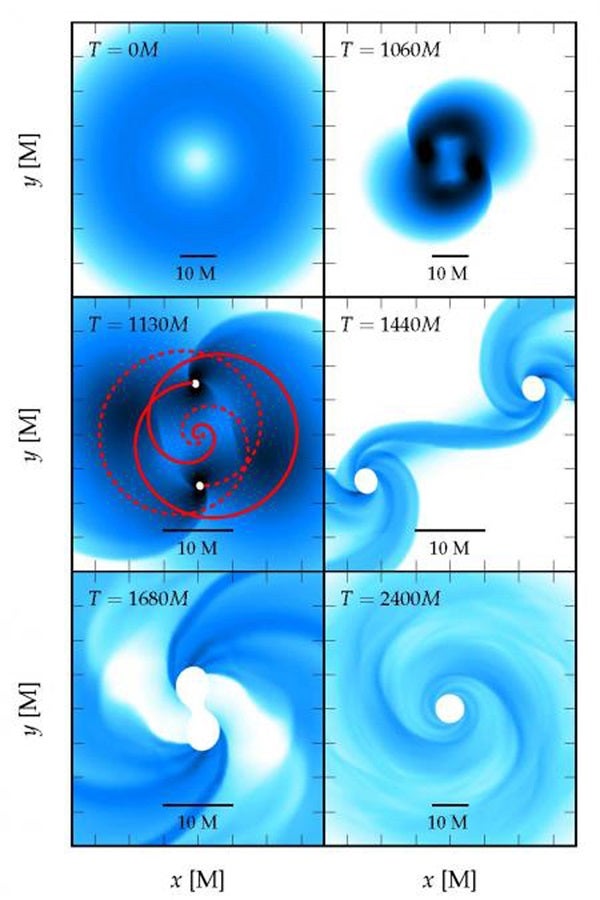Now, new findings by researchers at the California Institute of Technology (Caltech) in Pasadena, California, may help to test a model that solves this problem.
Certain models of supermassive black hole growth invoke the presence of “seed” black holes that result from the deaths of early stars. These seed black holes gain mass and increase in size by picking up the materials around them — a process called accretion — or by merging with other black holes. “But in these previous models, there was simply not enough time for any black hole to reach a supermassive scale so soon after the birth of the universe,” said Christian Reisswig from Caltech. “The growth of black holes to supermassive scales in the young universe seems only possible if the seed mass of the collapsing object was already sufficiently large.”
To investigate the origins of young supermassive black holes, Reisswig, in collaboration with Christian Ott from Caltech and other colleagues, turned to a model involving supermassive stars. These giant rather exotic stars are hypothesized to have existed for just a brief time in the early universe. Unlike ordinary stars, supermassive stars are stabilized against gravity mostly by their own photon radiation. In a very massive star, photon radiation — the outward flux of photons that is generated due to the star’s high interior temperatures — pushes gas from the star outward in opposition to the gravitational force that pulls the gas back in. When the two forces are equal, this balance is called hydrostatic equilibrium.
During its life, a supermassive star slowly cools due to energy loss through the emission of photon radiation. As the star cools, it becomes more compact, and its central density slowly increases. This process lasts for a couple of million years until the star has reached sufficient compactness for gravitational instability to set in and for the star to start collapsing gravitationally, Reisswig said.
Previous studies predicted that when supermassive stars collapse, they maintain a spherical shape that possibly becomes flattened due to rapid rotation. This shape is called an axisymmetric configuration. Incorporating the fact that rapidly spinning stars are prone to tiny perturbations, Reisswig and his colleagues predicted that these perturbations could cause the stars to deviate into non-axisymmetric shapes during the collapse. Such initially tiny perturbations would grow rapidly, ultimately causing the gas inside the collapsing star to clump and to form high-density fragments.
These fragments would orbit the center of the star and become increasingly dense as they picked up matter during the collapse; they would also increase in temperature. And then, Reisswig said, “an interesting effect kicks in.” At sufficiently high temperatures, there would be enough energy available to match electrons to their antiparticles, or positrons, into what are known as electron-positron pairs. The creation of electron-positron pairs would cause a loss of pressure, further accelerating the collapse; as a result, the two orbiting fragments would ultimately become so dense that a black hole could form at each clump. The pair of black holes might then spiral around one another before merging to become one large black hole. “This is a new finding,” Reisswig said. “Nobody has ever predicted that a single collapsing star could produce a pair of black holes that then merge.”
Reisswig and his colleagues used supercomputers to simulate a supermassive star that is on the verge of collapse. The simulation produced a video made by combining millions of points representing numerical data about density, gravitational fields, and other properties of the gases that make up the collapsing stars.
Although the study involved computer simulations and is thus purely theoretical, in practice, the formation and merger of pairs of black holes can give rise to tremendously powerful gravitational radiation — ripples in the fabric of space and time, traveling at the speed of light — that is likely to be visible at the edge of our universe, Reisswig said. Ground-based observatories such as the Laser Interferometer Gravitational-Wave Observatory (LIGO), co-managed by Caltech, are searching for signs of this gravitational radiation, which was first predicted by Albert Einstein in his general theory of relativity. Future space-borne gravitational-wave observatories, Reisswig said, will be necessary to detect the types of gravitational waves that would confirm these recent findings.
Ott said that these findings will have important implications for cosmology. “The emitted gravitational-wave signal and its potential detection will inform researchers about the formation process of the first supermassive black holes in the still young universe and may settle some — and raise new — important questions on the history of our universe,” he said.










